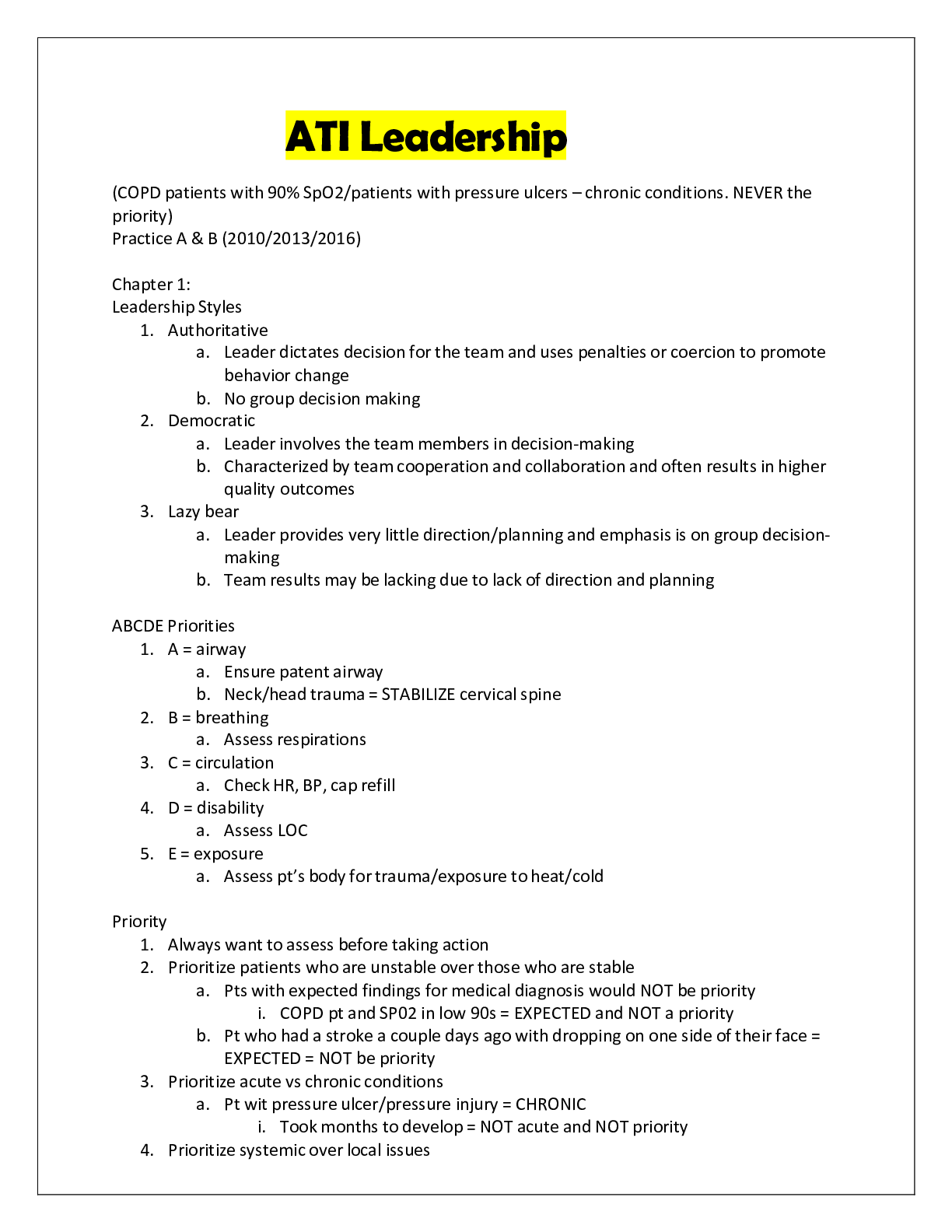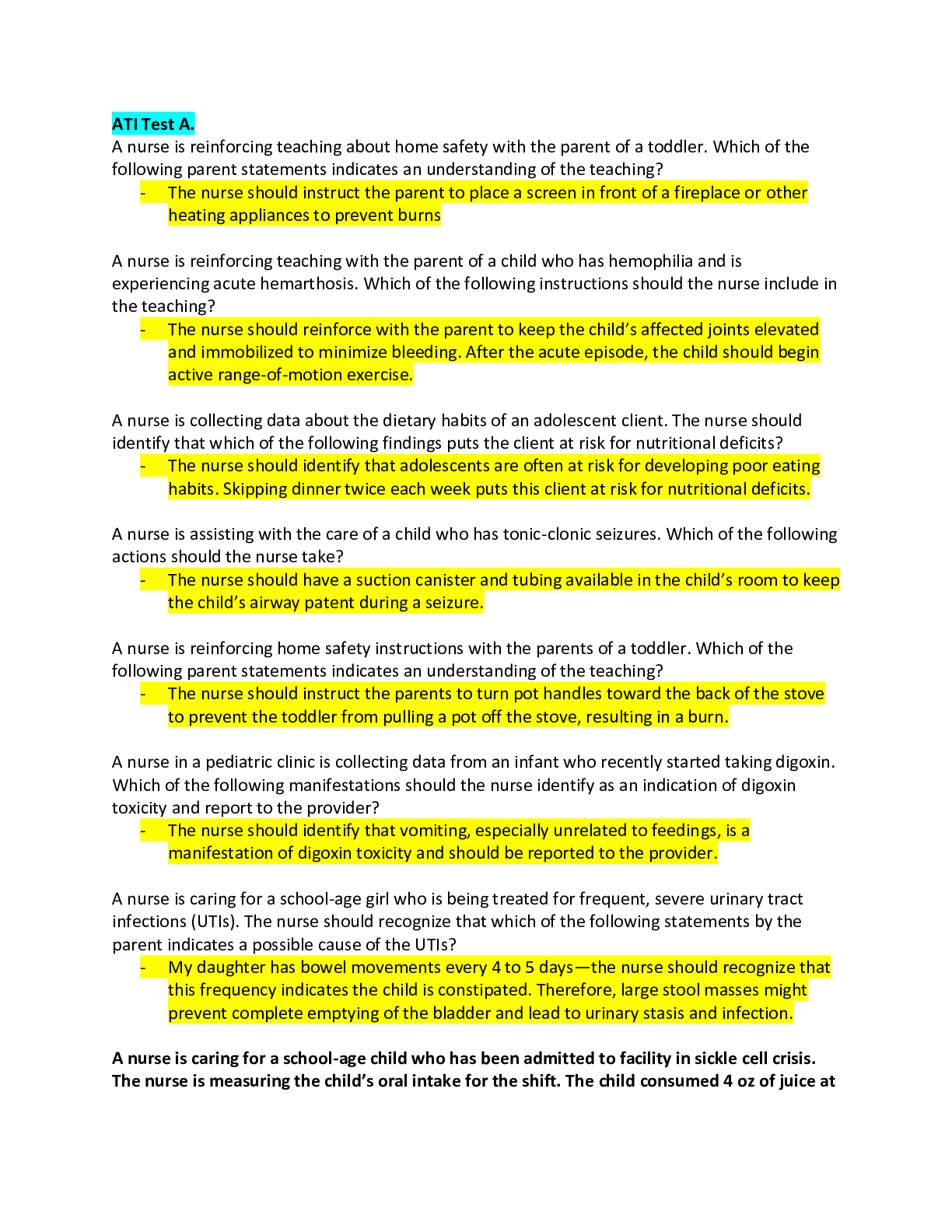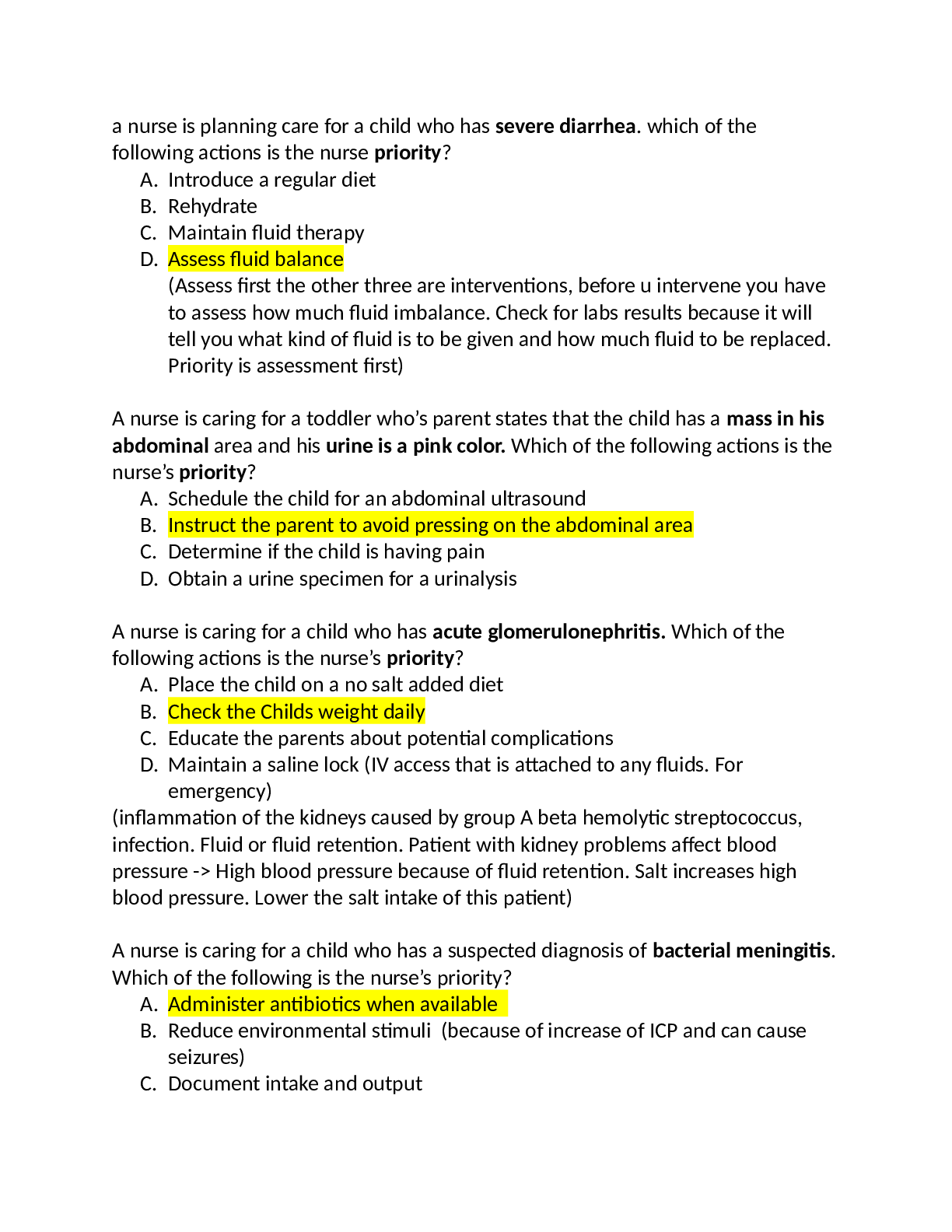Leadership > QUESTIONS and ANSWERS > ATI Leadership (All)
ATI Leadership
Document Content and Description Below
ATI Leadership ATI Leadership (COPD patients with 90% SpO2/patients with pressure ulcers – chronic conditions. NEVER the priority) Practice A & B (2010/2013/2016) Chapter 1: Leadership Sty... les 1. Authoritative a. Leader dictates decision for the team and uses penalties or coercion to promote behavior change b. No group decision making 2. Democratic a. Leader involves the team members in decision-making b. Characterized by team cooperation and collaboration and often results in higher quality outcomes 3. Lazy bear a. Leader provides very little direction/planning and emphasis is on group decision-making b. Team results may be lacking due to lack of direction and planning ABCDE Priorities 1. A = airway a. Ensure patent airway b. Neck/head trauma = STABILIZE cervical spine 2. B = breathing a. Assess respirations 3. C = circulation a. Check HR, BP, cap refill 4. D = disability a. Assess LOC 5. E = exposure a. Assess pt’s body for trauma/exposure to heat/cold Priority 1. Always want to assess before taking action 2. Prioritize patients who are unstable over those who are stable a. Pts with expected findings for medical diagnosis would NOT be priority i. COPD pt and SP02 in low 90s = EXPECTED and NOT a priority b. Pt who had a stroke a couple days ago with dropping on one side of their face = EXPECTED = NOT be priority 3. Prioritize acute vs chronic conditions a. Pt wit pressure ulcer/pressure injury = CHRONIC i. Took months to develop = NOT acute and NOT priority 4. Prioritize systemic over local issues a. Systemic symptoms: BP starts to decrease, it is a big deal and you want to give that patient priority b. Tachypnea/Tachycardia = SYSTEMIC RED FLAG c. Local issues = local pain or swelling is more indicative of local problem 5. Prioritize interventions using ABCDE framework a. Administer O2 to someone with dyspnea takes priority over giving pain medication to a patient b. Giving pain meds is NEVER the priority! 6. Choose least invasive and restrictive interventions over more invasive/restricting interventions a. High risk fall patients = move the patient closer to nursing station and set a bed alarm BEFORE putting them in restraints (last resort) 7. In a mass casualty event, prioritize those who have a chance or surviving over those who are expected to diet a. BLACK TAG (Class 4) = patients expected to die b. Focus attention on patients who actually have a chance at surviving Time Management 1. Complete charting on assessment/interventions ASAP a. Do not wait until after shift to complete charting 2. Try to group tasks that are for a single patient or for a patient that is located closer together to prevent repeated trips back and forth to supply room a. Mentally work through procedure/intervention and gather supplies as you are thinking about them 3. Complete difficult/time-consuming tasks EARLY on the shift NOT LATER because energy is higher 4. Perform non-essential tasks later on the day 5. Always complete tasks before starting new tasks 6. Always know when to delegate & when to ask for help a. If drowning in work, ask mentor nurse/charge nurse before it gets bad 7. Do not help other team members with low-priority tasks while you still have outstanding tasks to complete a. If it’s high priority, help them Delegation RN 1. As an RN, NEVER delegate anything that requires nursing judgement a. New admission, evaluate patient’s ability to swallow = ONLY FOR RN 2. Never delegate anything that requires patient education a. When teaching a patient, education on diagnosis = ONLY FOR RN 3. Nursing assessment a. Head-to-toe, assessment 4. Blood transfusions a. Requires 2nd RN to verify all information Delegating to LPN/LVN 1. Medication administration 2. Enteral feedings through NG/G tube 3. Urinary catheter insertion 4. Suctioning 5. Trach care 6. Reinforce patient teaching a. RN needs to do initial teaching, LPN/LVN can reinforce teaching 7. Check NG tube patency Delegating to UAP/CNA 1. Bathing 2. Dressing 3. Ambulating 4. Toileting 5. Feeding patients without swallowing difficulties 6. If patient has swallowing issues, it should NOT be delated to UAP/CAN …………………………………….CONTINUED………………………… [Show More]
Last updated: 2 years ago
Preview 1 out of 17 pages

Buy this document to get the full access instantly
Instant Download Access after purchase
Buy NowInstant download
We Accept:

Reviews( 0 )
$14.00
Can't find what you want? Try our AI powered Search
Document information
Connected school, study & course
About the document
Uploaded On
Jan 20, 2021
Number of pages
17
Written in
Additional information
This document has been written for:
Uploaded
Jan 20, 2021
Downloads
0
Views
122













 – Chamberlain College of Nursing.png)

